Phallus impudicus var. impudicus L. - Stinkhorn
Phylum: Basidiomycota - Class: Agaricomycetes - Order: Phallales - Family: Phallaceae
Distribution - Taxonomic History - Etymology - Toxicity - Identification - Reference Sources
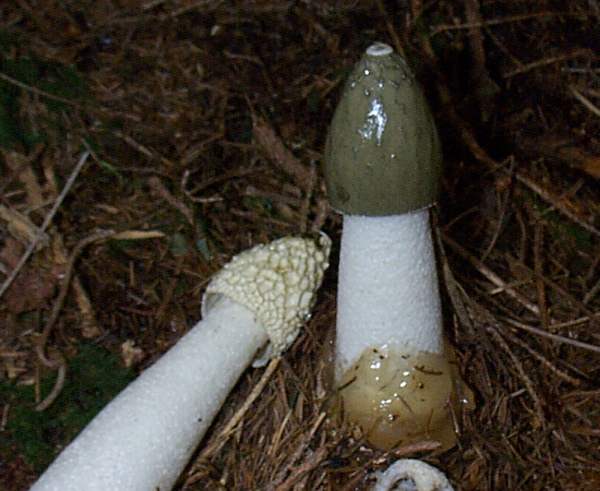
Phallus impudicus, the Stinkhorn, emerges from an underground 'egg'. The cap is initially covered with a smelly olive-green 'gleba' that attracts insects; they then distribute spores via their feet.
If you want to see these strange fungi, there is no need to go looking for them. Just follow your nose. Once you have found one, you will never forget the smell, and thereafter you will probably let out an involuntary yell of 'Stinkhorn' whenever you get wind of one! Early morning is the best time to look (or sniff) for this very smelly species.
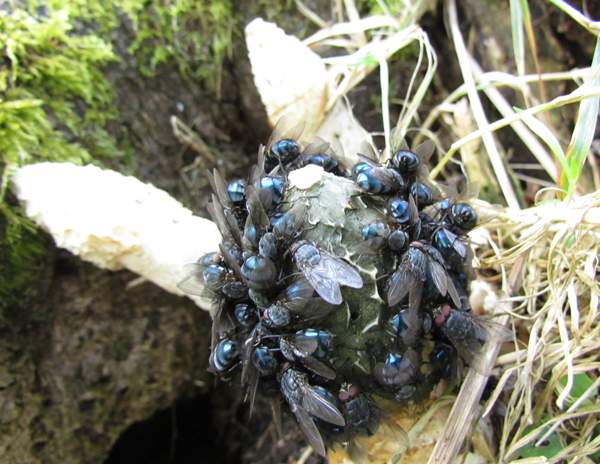
Stinkhorns are saprobic and generally gregarious, so where you find one just look around and you will probably be able to find several others at the 'egg' stage (see below). Some Victorians, including Charles Darwin's granddaughter Etty Darwin, were so disgusted or so embarrassed at the form of these phallic fungi that they attacked them with cudgels at dawn rather than allowing them to fruit and spread their spores. It is doubtful whether such actions could make much of an impression on the Stinkhorn population; however, the main purpose was to avoid letting the Stinkhorns make the 'bad impression' on any impressionable young ladies who might decide to take a morning walk in the woods!
Above: Flies have picked clean two of the Stinkhorns on this rotten hardwood stump at Gregynog National Nature Reserve, East Wales, and they are now dealing with the 'late arrival' to the feast.
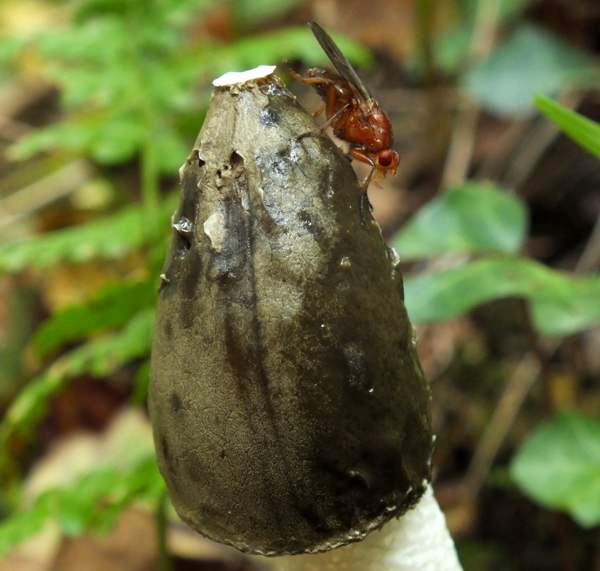
Distribution
Very common throughout Britain and Ireland, Phallus impudicus also occurs in most parts of mainland Europe from Scandinavia to the southernmost parts of the Iberian Peninsula and the shores of the Mediterranean. This species is also found in many western parts of North America.
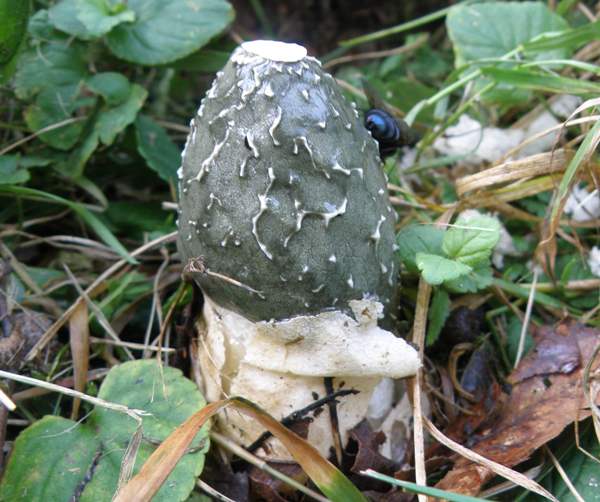
Taxonomic history
The nominate form Phallus impudicus var. impudicus was described in 1753 by Carl Linnaeus, who gave it the scientific name Phallus impudicus that it retains to this day. Synonyms of Phallus impudicus var. impudicus include Phallus foetidus Sowerby and Ithyphallus impudicus (L.) Fr.
Phallus impudicus var, togatus (Kalchbr.) Costantin & L.M. Dufour - synonyms include Dictyophora duplicata sensu auct. brit., and Hymenophallus togatus Kalchbr. - differs in having a veil that forms a lace-like skirt beneath the head of the fungus. This variety is a rare find in Britain.
Etymology
The genus name Phallus was chosen by Carl Linnaeus, and it is a reference to the phallic appearance of many of the fruitbodies within this fungal group.
The specific epithet impudicus is Latin for 'shameless' or 'immodest', and hence Phallus impudicus translates to 'shamelessly phallic'. This species is sometimes referred to as the Common Stinkhorn.
Toxicity
The vile smell of a mature Stinkhorn might be taken to suggest that these fungi are toxic or at least inedible; however, some people do eat them, but only at the 'egg' stage when the odour is not so evident. That said, I have heard of no instances of turf wars over the rights to gather these edible but hardly delectable fungi.
Identification guide
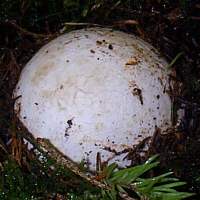 |
DevelopmentIt is fairly easy to find the 'eggs' of this species, because they are usually only partly buried in pine needles or leaf letter and the white skin stands out clearly. Eggs of the common stinkhorn can be found at any time of year, but they usually lie dormant until the summer months. |
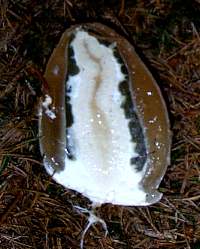 |
Within the egg the fruitbody develops. In this picture the stipe (stem) material is in the central column and the gleba, which bears the spores, surrounds it. The honeycomb texture of the cap beneath the gleba is also visible at this stage. If the eggs are gathered early enough, while their contents are white, their contents are edible. Stinkhorns are not much sought after, however, as there are many more attractive edible fungi. |
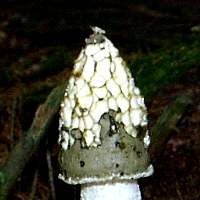 |
As soon as the cap emerges from the egg, insects attack it and eat the gleba. Some of the sticky gleba adheres to the legs of the insects, and that is how the spores get carried from one location to another. Note the honeycomb texture of the cap beneath the gleba. To find specimens in pristine conditions, you really need to visit the woods at dawn, before the flies have found any new stinkhorns that have burst from their eggs during the night. |
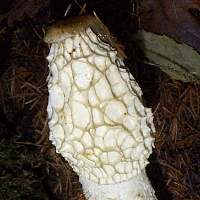 |
DescriptionBeneath the sticky olive-green gleba coating, the cap of the Common Stinkhorn has a raised honeycomb structure. This is all that many people ever see of the cap of this fungus because insects very quickly eat the spore-bearing gleba, at the same time getting some of it stuck to their legs so that spores get transported over quite large distances as the insects fly off in search of food elsewhere. |
Dimensions |
Typically 15 to 25cm tall; stipe diameter 2 to 4cm; cap 2.5 to 5cm across. |
Other features |
The 'egg' is typically 4 to 8cm in diameter, gradually becoming elongated until it ruptures and the stipe emerges very quickly, bearing the gleba-coated cap aloft. At the egg stage this fungus is said to be edible (although how anyone came to know this is an interesting point of debate!, but it is certainly not greatly valued as a source of food (except by flies!). |
Stem |
The white stipe has a texture and appearance of expanded polystyrene; it persists for several days after the gleba has been consumed by insects. |
SporesEllipsoidal to oblong, smooth, 3.5 x 1.5-2.5µm. Spore colourThe slimy gleba, which is dark olive, contains yellow spores. Their suspension in gleba makes it impossible to produce a conventional spore print.. |
|
Odour/taste |
A strong, unpleasant odour; no distinctive taste. |
Habitat |
Phallus impudicus is found in all kinds of woodland, but particularly common in coniferous forests. This saprobic fungus invariably appears near to dead tree stumps or other sources of rotting timber. |
Season |
June to October in Britain. |
Similar species |
Phallus hadriani, the Dune Stinkhorn, has a violet-coloured volva and is on average somewhat shorter; in Britain it is essentially confined to sand dunes. Mutinus caninus, the Dog Stinkhorn, is much smaller and has a weaker odour; its honeycombed cap surface is orange rather than white beneath the gleba. |
Reference Sources
Fascinated by Fungi, 2nd Edition, Pat O'Reilly 2016, reprinted by Coch-y-bonddu Books in 2022.
Pegler, D.N., Laessoe, T. & Spooner, B.M (1995). British Puffballs, Earthstars and Stinkhorns. Royal Botanic Gardens, Kew.
Dictionary of the Fungi; Paul M. Kirk, Paul F. Cannon, David W. Minter and J. A. Stalpers; CABI, 2008
Taxonomic history and synonym information on these pages is drawn from many sources but in particular from the British Mycological Society's GB Checklist of Fungi.
Fascinated by Fungi. Back by popular demand, Pat O'Reilly's best-selling 450-page hardback book is available now. The latest second edition was republished with a sparkling new cover design in September 2022 by Coch-y-Bonddu Books. Full details and copies are available from the publisher's online bookshop...

